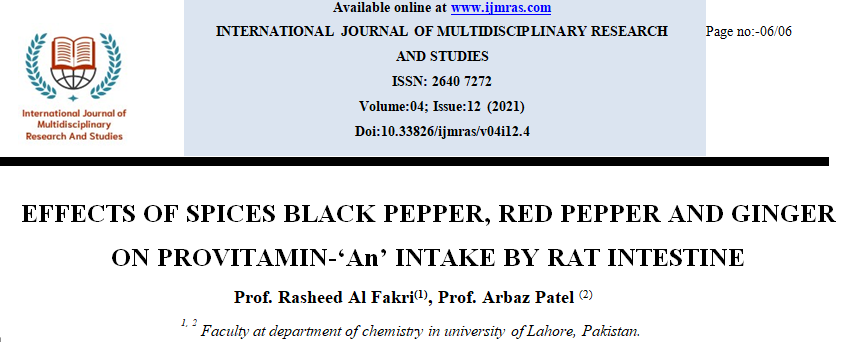THE EFFECTS OF SPICES BLACK PEPPER, RED PEPPER AND GINGER ON PROVITAMIN-‘An’ INTAKE BY RAT INTESTINE

Abstract
Vitamin ‘’A ‘’deficiency in the plant food addiction population, it is desirable to improve the bioavailability of pro-vitamin A. Certain spices can alter the ultrafine structure and permeability of the intestine. Here, by examining the intestinal absorption of rats fed black pepper, red pepper, ginger, piperine, and capsaicin, some common spices are given for the possible effects of pro-vitamin A on intestinal absorption. I looked it up. Higher in vitro absorption of pro-vitamin A in the intestine has been demonstrated in all spiced animals. Dietary piperine and ginger increased pro-vitamin A intake by 147% and 98%, respectively. Absorption of animals fed black pepper and red pepper increased by 59% and 27%, respectively, while capsaicin from the diet increased by 50%. Therefore, significantly improved intestinal absorption of beta-carotene has been demonstrated as a result of the consumption of hot spices, which may form a food-based strategy that may reduce vitamin A deficiency.20
Keywords
Pro Vitamin-A; Spices; Micronutrient Deficiency; Intestinal Uptake;How to Cite
References
Atal et al., 1981 C.K. Atal, U. Zutshi, P.G. Rao Scientific evidence on the role of Ayurvedic herbals on the bioavailability of drugs Journal
of Ethnopharmacology, 4 (1981), pp. 229-232
Bernhart and Tomaselli, 1966 F.W. Bernhart, R.M. Tomarelli A salt mixture supplying the National Research Council estimates of the
mineral requirements of the rat Journal of Nutrition, 89 (1966), p. 495
Gayathri et al., 2004 G.N. Gayathri, K. Platel, J. Prakash, K. Srinivasan Influence of antioxidant spices on the retention of β-carotene in
vegetables during domestic cooking processes Food Chemistry, 84 (2004), pp. 35-43
Johri et al., 1992 R.K. Johri, N. Thus, A. Khajuria, U. Zutshi Piperine-mediated changes in the permeability of rat intestinal epithelial
cells: Status of γ-glutamyl transpeptidase activity, uptake of amino acids and lipid peroxidationBiochemical Pharmacology, 43 (1992),
pp. 1401-1407
Hedren et al., 2002 E. Hedren, G. Mulkozi, U. Svanberg In vitro accessibility of carotenes from green leafy vegetables cooked with
sunflower oil or red palm oil International Journal of Food Science and Nutrition, 53 (2002), pp. 445-453
Khajuria et al., 2002 A. Khajuria, N. Thus, U. Zutshi Piperine modulates permeability characteristics of the intestine by inducing
alterations in membrane dynamics: influence on brush border membrane fluidity, ultrastructure, and enzyme kinetics Phytomedicine,
(2002), pp. 224-231
Mercado et al., 1989 R.J.D. Mercado, S.C. Holmgren, J.G. Fox, R.M. Russel Dietary β-carotene absorption and metabolism in ferrets and
rats Journal of Nutrition, 119 (1989), pp. 665-669 Google Scholar
National Research Council, 1972 National Research Council (1972). Nutrient requirements of laboratory animals (no. 10, revised 1972).
Washington, DC: National Academy of Sciences, National Research Council. Google Scholar
Ogulensi and Lee, 1979 A.T. Ogulensi, C.Y. Lee Effect of thermal processing on the stereo isomerization of major carotenoids and
vitamin A value of carrots Food Chemistry, 4 (1979), pp. 311-318 Google Scholar
Rodriguez and Irwin, 1972 M.S. Rodriguez, M.I. Irwin A prospectus of research in vitamin requirement of manJournal of Nutrition, 23
(1972), pp. 105-108 Google Scholar
Snedecor and Cochran, 1976 Snedecor, G. W., & Cochran, W. G. (1976). Statistical methods (6th ed.). Ames, USA: Iowa State Univ.
Press, p. 298. Google Scholar
Srinivasan, 2005 K. Srinivasan Role of spices beyond food flavouring: Nutraceuticals with multiple health effectsFood Reviews
International, 21 (2005), pp. 167-188
Srinivasan, 2007 K. Srinivasan Black pepper and its pungent principle – Piperine: A review of diverse physiological effects Critical
Reviews in Food Science and Nutrition, 47 (2007), pp. 735-748View PDF
Srinivasan, 2008 K. Srinivasan Reason to the season: Spices as functional food adjuncts with multiple health effects Indian Food
Industry, 27 (5) (2008), pp. 36-47 View Record in ScopusGoogle Scholar
Srinivasan, 2009 K. Srinivasan Black pepper (Piper nigrum) and its bioactive compound piperineB.B. Aggarwal, A.B. Kunnumakkara
(Eds.), Molecular targets and therapeutic uses of spices: Modern uses for ancient medicine, World Scientific Publishing Co. Inc,
Ames, USA (2009), pp. 25-64 View PDF
Suresh and Srinivasan, 2007 D. Suresh, K. Srinivasan Studies on the in vitro absorption of spice principles – curcumin, capsaicin and
piperine in rat intestines Food and Chemical Toxicology, 45 (2007), pp. 1437-1442
Veda et al., 2006 S. Veda, A. Kamath, K. Platel, K. Begum, K. Srinivasan Determination of bioaccessibility of β-carotene in vegetables
by in vitro methods Molecular Nutrition and Food Research, 50 (2006), pp. 1047-1052
View PDF
Veda et al., 2008 S. Veda, K. Platel, K. Srinivasan Influence of food acidulants and antioxidant spices on the bioaccessibility of β-
carotene from selected vegetables Journal of Agricultural and Food Chemistry, 56 (2008), pp. 8714-8719
View PDF
World Health Organization, 1998 World Health Organization (1998). Studies Rebut the Concept that the body stores vitamin A-
making substances (pp. 1–2). Geneva: WHO Report. 20 Source
https://www.sciencedirect.com/science/article/pii/S1756464609000656
License
Copyright (c) 2021 IJMRASIndividual articles are published Open Access under the Creative Commons Licence: CC-BY 4.0.



